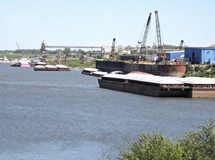 |
 |
|
| eNews • October 2012 | ||
| Promoting a Cost-Effective, Reliable and Competitive Transportation System |
||
 Mississippi River traffic moving again near Granite City
Mississippi River traffic moving again near Granite City
Mississippi River traffic was moving again on September 20th, albeit slowly, after busy Lock 27 was reopened near Granite City, Illinois - north of St. Louis.
Damage to a structure protecting the busy lock on the Chain of Rocks Canal had brought commercial barge traffic to a standstill on the upper Mississippi River as crews made emergency repairs.
Lt. Colin Fogarty of the U.S. Coast Guard said traffic got the green light to start moving through the lock at 3:30 a.m. on September 20.
By the time the lock reopened, there were 63 vessels, with a total of 455 barges, backed up and waiting to pass.
The damaged barrier, a large cylindrical cell, was discovered on September 15 after rock spilled out of it near the opening of the lock. Precariously low water levels on the river had exposed one of the less-fortified sections of the cell.
Lock 27 itself, the busiest on this stretch of the Mississippi, was not damaged.
"This doesn't happen that often, where we have a closure that affects (river traffic) as completely as this," explained Mike Petersen, a spokesman for the Army Corps of Engineers in St. Louis.
It is unclear how the protection cell was damaged — whether from a single hit or repeated impacts, Petersen said.
The large metal cylinder serves as a bumper, of sorts, letting towboat pilots guide the barges into the lock. The cell is filled with rock. The damaged portion typically sits 15 to 20 feet below normal river levels and is not armored.
The damage caused rock to spill from the cell and blocked the flow of barge traffic, Petersen said.
Repairs to the structure were expected to cost about $500,000, according to a corps official. The emergency repair involved removing 5,000 tons of rock from the cell and stuffing sand bags into the damaged section.
Replacing the cell, which was built in 1985, will cost an additional $2 million, said Andy Schimpf, an operations manager for the corps.
Fogarty said the low water already had taken its toll on river commerce. He likened it to "taking an eight-lane highway and making it into a four-lane highway."
Schimpf said closure of the river because of the cell damage cost the shipping industry about $3 million a day in lost revenue.
"There is a huge ripple effect that we're not able to capture," he said.
Barges caught in the river closure were carrying enough agricultural products, fertilizer, construction material and other products to fill 5,600 rail cars, or 24,300 tractor-trailers, Fogarty said.
Rick Calhoun, president of Cargo Carriers, a subsidiary of Cargill Inc., said the closure was particularly disruptive because everything going north and south on the upper Mississippi must go through Lock 27.
"What happens is that transportation assets grind to a halt," he said. "It's an unfortunate accident. Nonetheless, it ended up costing the industry, the customers and eventually the country a lot of money. When a piece of transportation grinds to a halt, it changes from being an asset to a liability."
Drought conditions in the Midwest and low water on inland waterways has made this a difficult season for shippers.
It has been marked by frequent groundings and temporary river shutdowns, Calhoun said, particularly on the lower Mississippi, which has no locks and dams to moderate sharp rises and falls in the river.
Source: St. Louis Post Dispatch
Soy Transportation Coalition |
|
